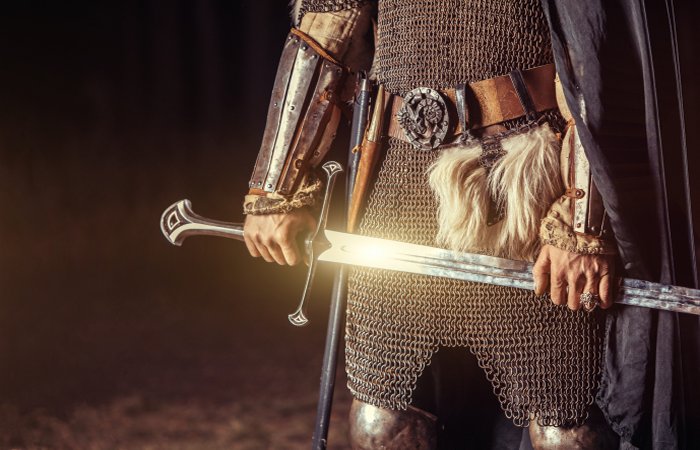Sword-Kladenets – Hidden Treasure Awaiting A Worthy Hero
A. Sutherland - AncientPages.com - In folklore and storytelling, swords were companions to heroes, and the spirit of each blade was very sensitive to the spirit of its owner.
They have been made in many shapes and sizes since at least the second millennium BC.
The sword-kladenets is a hidden treasure and can only be obtained by a worthy hero. Credit: diter - Adobe Stock
They ranged from the short sword ('gladius') dated to the Roman time used by gladiators to the famous Scottish claymore, which was almost as long as a man was tall (140 cm (55 in) in overall length).
Made from every metal that would hold an edge or a point from bronze to steel, the swords were often engraved with symbols, runes, or other signs.
From Times Of Ancient Greeks To Era Of Roman Emperor
Charlemagne, all heroes bore specially named swords. Legendary weapons have been described in legends and fables of ancient people in many cultures.
These weapons helped heroes ward off attacks fighting vicious enemies, defeat any evil force, free innocent hostages, or perform some of their famous feats.
In some heroic poems and ancient Russian legends, a sword, Kladenets, acts as a self-cutting sword, which, on the orders of its owner, can cut down an entire forest or at least the whole enemy army. Other weapons could heal or make their owners or holders – invulnerable. One of the unique weapons with extraordinary supernatural powers was Fragarach, known as "The Retaliator," which was forged by gods for gods only. Fragarach - a unique, magical sword - could control winds and cut through wood and metal.
Folkloric tradition says that sword-kladenets are genuinely formidable heroic weapons with magical power that gives their owners invincibility. The unbelievable abilities of the sword-kladenets can be compared to those possessed by Paracelsus' mysterious sword. It was reported that his sword was alive! It could dance and frequently made a continuous rattling sound, waking up Paracelsus's neighbors.
Some old rumors say that Paracelsus slept with a strange sword by his side. Did he keep it for his protection? The sword Azoth was one reason Paracelsus became suspected of threatening behavior and contact with dark and evil forces.
Who Can Get Sword-Kladenets?
The sword-kladenets - also known as "sword of steel," "hidden sword," or "magic sword" - can only be obtained by a worthy hero. He has to find this precious object hidden in the ground, inside a wall, and sometimes hidden/behind a stove, a rock, or under a sacred tree.
Sometimes, a hero must dig this sword from a mound or grave because, according to ancient belief, the weapon belongs to the dead with exceptional magical powers.
The hero must prove his strength and ability to raise the stove, unfold the wall, or find a weapon in other places, such as under the decapitated body of a hero on the battlefield.
Why Was Sword-Kladenets A Treasure?
According to some scholars, the word in Russian means "treasure" of extraordinary value, and, in ancient times, this kind of weapon was considered a treasure.
Was it because it had magical properties or perhaps because it was made of steel? Steel swords were a rarity in ancient times, which means they were associated with magical properties.
Flawed quality pieces - usually corroded by rust - were useless. After they were dug up and cleaned of rye, other swords still demonstrated the high-quality metal from which they were forged.
Sword Kladenets was not only featured in fabulous stories about East Slavic culture. In ancient Greek mythology, Aegeus, one of the primordial kings of Athens, buried his formidable sword under a huge rock. Then, he told his wife, who was waiting for a child, that if they had a boy who grew strong enough to roll away the stone and get the things beneath it, she could send him to Athens to claim his royal parentage.
The sword Kladenets, however, is traditionally attributed to legendary Russian heroes of mythical times.
Written by – A. Sutherland - AncientPages.com Senior Staff Writer
Updated on March 26, 2024
Copyright © AncientPages.com All rights reserved. This material may not be published, broadcast, rewritten, or redistributed in whole or part without the express written permission of AncientPages.com
More From Ancient Pages
-
 Why Were Viking Raids So Successful?
Ancient History Facts | Aug 3, 2016
Why Were Viking Raids So Successful?
Ancient History Facts | Aug 3, 2016 -
 7,000-Year-Old Male Skeleton In Garment Decorated With Sea Shells, Red Deer Teeth Identified In France
Archaeology | Mar 9, 2017
7,000-Year-Old Male Skeleton In Garment Decorated With Sea Shells, Red Deer Teeth Identified In France
Archaeology | Mar 9, 2017 -
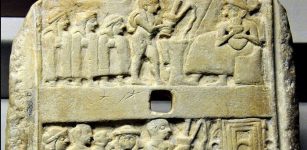 Ur – One Of The Largest And Most Important Cities Of Ancient Mesopotamia
Featured Stories | Jul 28, 2021
Ur – One Of The Largest And Most Important Cities Of Ancient Mesopotamia
Featured Stories | Jul 28, 2021 -
 Lares: Roman Household Gods That Protected Home And Family
Ancient Traditions And Customs | Dec 14, 2020
Lares: Roman Household Gods That Protected Home And Family
Ancient Traditions And Customs | Dec 14, 2020 -
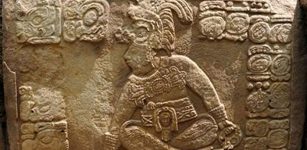 On This Day In History: Maya King Yuknoom Ixquiac ‘Jaguar Paw Smoke’ Assumes The Crown Of Calakmul – On Apr 3, 686
News | Apr 3, 2017
On This Day In History: Maya King Yuknoom Ixquiac ‘Jaguar Paw Smoke’ Assumes The Crown Of Calakmul – On Apr 3, 686
News | Apr 3, 2017 -
 First Known Depiction Of The Biblical Heroines Deborah And Jael Unearthed On 1,600-Year-Old Mosaics
Archaeology | Jul 6, 2022
First Known Depiction Of The Biblical Heroines Deborah And Jael Unearthed On 1,600-Year-Old Mosaics
Archaeology | Jul 6, 2022 -
 Radar Reveals ‘Ghost’ Footprints From Pleistocene Era
Archaeology | Nov 13, 2019
Radar Reveals ‘Ghost’ Footprints From Pleistocene Era
Archaeology | Nov 13, 2019 -
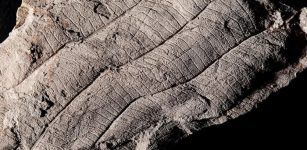 First Leaf Fossils Study Reveals An Ancient 4 Million-Year-Old Forest In Borneo
Fossils | May 3, 2022
First Leaf Fossils Study Reveals An Ancient 4 Million-Year-Old Forest In Borneo
Fossils | May 3, 2022 -
 Roman-Byzantine Grave Unearthed In Turkey
Archaeology | Jan 28, 2016
Roman-Byzantine Grave Unearthed In Turkey
Archaeology | Jan 28, 2016 -
 Half-A-Million Year Old Signs Of Extinct Human Species Discovered In Polish Cave
Archaeology | Nov 30, 2022
Half-A-Million Year Old Signs Of Extinct Human Species Discovered In Polish Cave
Archaeology | Nov 30, 2022 -
 Stunning Reconstruction Of Caterthun Iron Age Forts In The Grampian Mountains, Scotland
Civilizations | Nov 17, 2016
Stunning Reconstruction Of Caterthun Iron Age Forts In The Grampian Mountains, Scotland
Civilizations | Nov 17, 2016 -
 Norse Kingdom Of Dublin Was Founded By The Vikings In 839 A.D.
Ancient History Facts | Mar 15, 2016
Norse Kingdom Of Dublin Was Founded By The Vikings In 839 A.D.
Ancient History Facts | Mar 15, 2016 -
 Mounds In Louisiana, North America Offer Insight Into Middle Archaic Lifestyles
Archaeology | Dec 2, 2022
Mounds In Louisiana, North America Offer Insight Into Middle Archaic Lifestyles
Archaeology | Dec 2, 2022 -
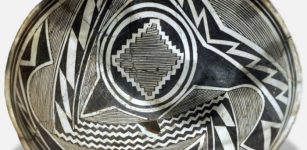 Expressive Beautiful And Celebrated Bowls Created By Mimbres Artisans From Distant Past
Artifacts | Oct 9, 2023
Expressive Beautiful And Celebrated Bowls Created By Mimbres Artisans From Distant Past
Artifacts | Oct 9, 2023 -
 Modern Humans Did Not Enter Europe By Sea – New Study Says
Archaeology | Mar 7, 2022
Modern Humans Did Not Enter Europe By Sea – New Study Says
Archaeology | Mar 7, 2022 -
 Tomb Of Christopher Columbus Finally Found But There Is One Problem With His Body
Archaeology | Apr 9, 2022
Tomb Of Christopher Columbus Finally Found But There Is One Problem With His Body
Archaeology | Apr 9, 2022 -
 Amazing Time Capsule – La Roche-Cotard Cave Sealed For 50,000-Years Offers Evidence Neanderthals Were The World’s First Artists
Archaeology | Nov 22, 2023
Amazing Time Capsule – La Roche-Cotard Cave Sealed For 50,000-Years Offers Evidence Neanderthals Were The World’s First Artists
Archaeology | Nov 22, 2023 -
 Legendary Basilisk With Deadly Petrifying Stare – King Of The Serpents
Featured Stories | Dec 27, 2021
Legendary Basilisk With Deadly Petrifying Stare – King Of The Serpents
Featured Stories | Dec 27, 2021 -
 William Marshal Earl Of Pembroke: Master Of Tournaments And Best Example Of Medieval Chivalry And Knighthood
Featured Stories | Jul 7, 2017
William Marshal Earl Of Pembroke: Master Of Tournaments And Best Example Of Medieval Chivalry And Knighthood
Featured Stories | Jul 7, 2017 -
 Gonzalo Guerrero – The Renegade Who Joined The Maya Against His Own People
Featured Stories | Feb 27, 2020
Gonzalo Guerrero – The Renegade Who Joined The Maya Against His Own People
Featured Stories | Feb 27, 2020

